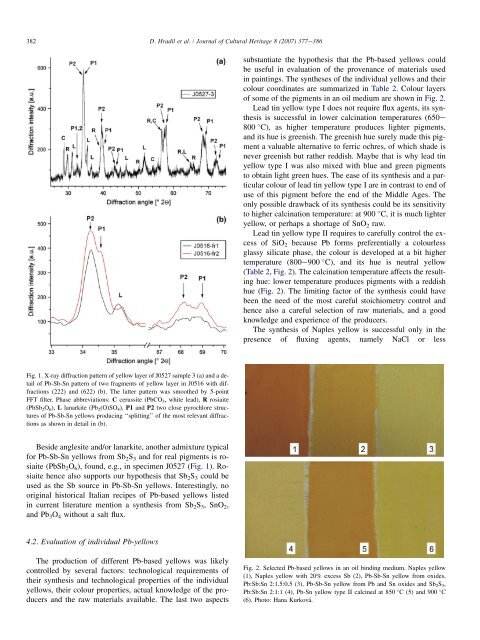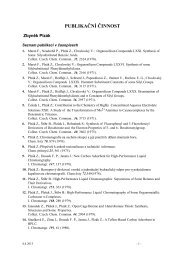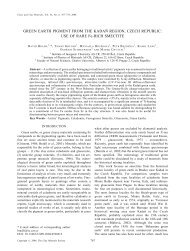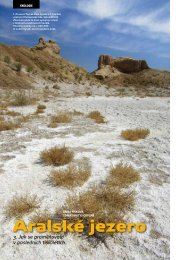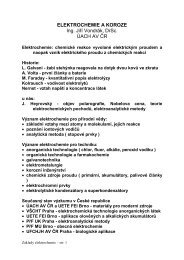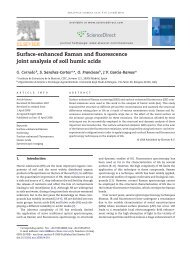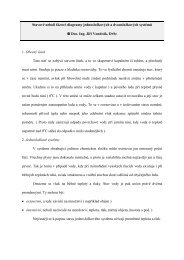Microanalytical identification of Pb-Sb-Sn yellow pigment in ...
Microanalytical identification of Pb-Sb-Sn yellow pigment in ...
Microanalytical identification of Pb-Sb-Sn yellow pigment in ...
You also want an ePaper? Increase the reach of your titles
YUMPU automatically turns print PDFs into web optimized ePapers that Google loves.
382 D. Hradil et al. / Journal <strong>of</strong> Cultural Heritage 8 (2007) 377e386<br />
substantiate the hypothesis that the <strong>Pb</strong>-based <strong>yellow</strong>s could<br />
be useful <strong>in</strong> evaluation <strong>of</strong> the provenance <strong>of</strong> materials used<br />
<strong>in</strong> pa<strong>in</strong>t<strong>in</strong>gs. The syntheses <strong>of</strong> the <strong>in</strong>dividual <strong>yellow</strong>s and their<br />
colour coord<strong>in</strong>ates are summarized <strong>in</strong> Table 2. Colour layers<br />
<strong>of</strong> some <strong>of</strong> the <strong>pigment</strong>s <strong>in</strong> an oil medium are shown <strong>in</strong> Fig. 2.<br />
Lead t<strong>in</strong> <strong>yellow</strong> type I does not require flux agents, its synthesis<br />
is successful <strong>in</strong> lower calc<strong>in</strong>ation temperatures (650e<br />
800 C), as higher temperature produces lighter <strong>pigment</strong>s,<br />
and its hue is greenish. The greenish hue surely made this <strong>pigment</strong><br />
a valuable alternative to ferric ochres, <strong>of</strong> which shade is<br />
never greenish but rather reddish. Maybe that is why lead t<strong>in</strong><br />
<strong>yellow</strong> type I was also mixed with blue and green <strong>pigment</strong>s<br />
to obta<strong>in</strong> light green hues. The ease <strong>of</strong> its synthesis and a particular<br />
colour <strong>of</strong> lead t<strong>in</strong> <strong>yellow</strong> type I are <strong>in</strong> contrast to end <strong>of</strong><br />
use <strong>of</strong> this <strong>pigment</strong> before the end <strong>of</strong> the Middle Ages. The<br />
only possible drawback <strong>of</strong> its synthesis could be its sensitivity<br />
to higher calc<strong>in</strong>ation temperature: at 900 C, it is much lighter<br />
<strong>yellow</strong>, or perhaps a shortage <strong>of</strong> <strong>Sn</strong>O 2 raw.<br />
Lead t<strong>in</strong> <strong>yellow</strong> type II requires to carefully control the excess<br />
<strong>of</strong> SiO 2 because <strong>Pb</strong> forms preferentially a colourless<br />
glassy silicate phase, the colour is developed at a bit higher<br />
temperature (800e900 C), and its hue is neutral <strong>yellow</strong><br />
(Table 2, Fig. 2). The calc<strong>in</strong>ation temperature affects the result<strong>in</strong>g<br />
hue: lower temperature produces <strong>pigment</strong>s with a reddish<br />
hue (Fig. 2). The limit<strong>in</strong>g factor <strong>of</strong> the synthesis could have<br />
been the need <strong>of</strong> the most careful stoichiometry control and<br />
hence also a careful selection <strong>of</strong> raw materials, and a good<br />
knowledge and experience <strong>of</strong> the producers.<br />
The synthesis <strong>of</strong> Naples <strong>yellow</strong> is successful only <strong>in</strong> the<br />
presence <strong>of</strong> flux<strong>in</strong>g agents, namely NaCl or less<br />
Fig. 1. X-ray diffraction pattern <strong>of</strong> <strong>yellow</strong> layer <strong>of</strong> J0527 sample 3 (a) and a detail<br />
<strong>of</strong> <strong>Pb</strong>-<strong>Sb</strong>-<strong>Sn</strong> pattern <strong>of</strong> two fragments <strong>of</strong> <strong>yellow</strong> layer <strong>in</strong> J0516 with diffractions<br />
(222) and (622) (b). The latter pattern was smoothed by 5-po<strong>in</strong>t<br />
FFT filter. Phase abbreviations: C cerussite (<strong>Pb</strong>CO 3 , white lead), R rosiaite<br />
(<strong>Pb</strong><strong>Sb</strong> 2 O 6 ), L lanarkite (<strong>Pb</strong> 2 (O)SO 4 ), P1 and P2 two close pyrochlore structures<br />
<strong>of</strong> <strong>Pb</strong>-<strong>Sb</strong>-<strong>Sn</strong> <strong>yellow</strong>s produc<strong>in</strong>g ‘‘splitt<strong>in</strong>g’’ <strong>of</strong> the most relevant diffractions<br />
as shown <strong>in</strong> detail <strong>in</strong> (b).<br />
Beside anglesite and/or lanarkite, another admixture typical<br />
for <strong>Pb</strong>-<strong>Sb</strong>-<strong>Sn</strong> <strong>yellow</strong>s from <strong>Sb</strong> 2 S 3 and for real <strong>pigment</strong>s is rosiaite<br />
(<strong>Pb</strong><strong>Sb</strong> 2 O 6 ), found, e.g., <strong>in</strong> specimen J0527 (Fig. 1). Rosiaite<br />
hence also supports our hypothesis that <strong>Sb</strong> 2 S 3 could be<br />
used as the <strong>Sb</strong> source <strong>in</strong> <strong>Pb</strong>-<strong>Sb</strong>-<strong>Sn</strong> <strong>yellow</strong>s. Interest<strong>in</strong>gly, no<br />
orig<strong>in</strong>al historical Italian recipes <strong>of</strong> <strong>Pb</strong>-based <strong>yellow</strong>s listed<br />
<strong>in</strong> current literature mention a synthesis from <strong>Sb</strong> 2 S 3 ,<strong>Sn</strong>O 2 ,<br />
and <strong>Pb</strong> 3 O 4 without a salt flux.<br />
4.2. Evaluation <strong>of</strong> <strong>in</strong>dividual <strong>Pb</strong>-<strong>yellow</strong>s<br />
The production <strong>of</strong> different <strong>Pb</strong>-based <strong>yellow</strong>s was likely<br />
controlled by several factors: technological requirements <strong>of</strong><br />
their synthesis and technological properties <strong>of</strong> the <strong>in</strong>dividual<br />
<strong>yellow</strong>s, their colour properties, actual knowledge <strong>of</strong> the producers<br />
and the raw materials available. The last two aspects<br />
Fig. 2. Selected <strong>Pb</strong>-based <strong>yellow</strong>s <strong>in</strong> an oil b<strong>in</strong>d<strong>in</strong>g medium. Naples <strong>yellow</strong><br />
(1), Naples <strong>yellow</strong> with 20% excess <strong>Sb</strong> (2), <strong>Pb</strong>-<strong>Sb</strong>-<strong>Sn</strong> <strong>yellow</strong> from oxides,<br />
<strong>Pb</strong>:<strong>Sb</strong>:<strong>Sn</strong> 2:1.5:0.5 (3), <strong>Pb</strong>-<strong>Sb</strong>-<strong>Sn</strong> <strong>yellow</strong> from <strong>Pb</strong> and <strong>Sn</strong> oxides and <strong>Sb</strong> 2 S 3 ,<br />
<strong>Pb</strong>:<strong>Sb</strong>:<strong>Sn</strong> 2:1:1 (4), <strong>Pb</strong>-<strong>Sn</strong> <strong>yellow</strong> type II calc<strong>in</strong>ed at 850 C (5) and 900 C<br />
(6). Photo: Hana Kurková.


